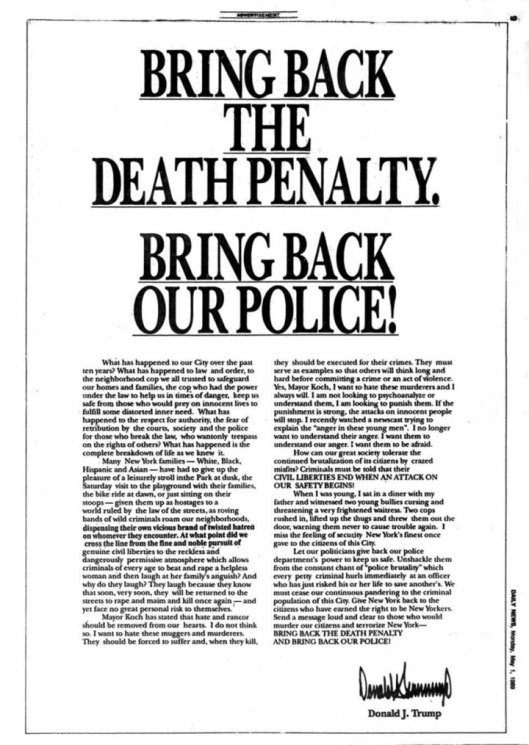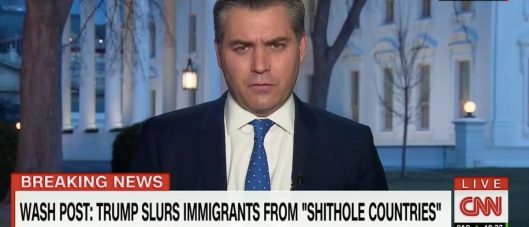Tags
Last Thursday, during a meeting on a bipartisan immigration deal in the Oval Office, President Trump asked, “Why are we having all these people from shithole countries come here?” He was specifically referring to immigrants from Haiti, El Salvador, and other countries in Africa. Instead the president desired more immigrants from nations like Norway, whose prime minister he had recently met. The president’s racist comments, reported by the Washington Post and picked up by other news outlets, shocked the news media, garnering intense coverage. Yet, when examining Trump’s behavior and public statements, there’s nothing new or surprising about his language or the sentiment behind it.
Trump has a long history of making racist, sexist, and xenophobic remarks. He bragged about sexually assaulting women. He failed to condemn white supremacists in Charlottesville, saying there were “some very fine people” on both sides. He has attacked African-American athletes for protesting racial injustice by kneeling during the national anthem. Before becoming president, he continually demanded the execution of the “Central Park Five.” The five men, four African-Americans and one Latino, had been falsely convicted of raping a jogger in Central Park in the late 1980s. For years, he peddled the lie that President Obama was not an American citizen. The Washington Post has compiled a handy list of Trump complaints against non-white immigrants. He decried Mexico for sending drug dealers and rapists to the United States. He worried that Syrian refugees might be “ISIS-affiliated.” He claimed that Haitian immigrants “all have AIDS.” He lamented that Nigerian immigrants, once settled in America, would “never go back to their huts.”

In the past, media outlets have covered Trump’s remarks, but employed euphemistic language to describe them. For example, the Chicago Tribune described Trump’s comments on Haitian and Nigerian immigrants as “offensive remarks.” Similar news headlines and stories over the past two years used phrases like “racially tinged” or “racially charged” to describe Trump’s words. These euphemisms, however, deny and obfuscate the true meaning and intent of Trump’s words. News outlets that mask the president’s meaning fail in their duty to accurately present information to their readers or viewers. Their behavior is reminiscent of the way high school and college students are loath to discuss the racist language or brutality found in studying the Holocaust, forms of slavery, and other atrocities. For some, to contemplate these horrors is too much to bear. But for many others, they prefer to avoid discussing such subjects altogether rather than discuss something important and uncomfortable. On some level, we’d all much rather pretend that the President of the United States isn’t a racist rather than confront the truth of the matter.
So the question becomes, why has the news media now decided to shed its squeamishness about Trump’s racism?
I believe the answer lies in the undeniable frankness of the President’s language. There is no room for nuance or interpretation. It also highlights the different ways that people define racism. In Arlie Russell Hochschild’s Strangers in Their Own Land, she notes that members of the Louisiana Tea Party “defined as racist a person who used the ‘N’ word or who ‘hates’ blacks.” This is the narrow definition of racism and it’s one shared by a large number of Americans across the political spectrum. Hochschild’s own definition (and one shared by many others) stressed that “racism refers to the belief in a natural hierarchy that places blacks at the bottom, and the tendency of whites to judge their own worth by distance from that bottom.” This broader definition, Hochschild stresses, means that racism is not geographically limited and it “appears not simply in personal attitudes but in structural arrangements” (146-147). I would push that definition even further to stress that racism also includes ideas about class, sex, and gender as well.

The media generally follows the narrow definition of racism. They eschew the word racist and identifying words as racist except in the most extreme and direct examples, like Trump’s “shithole” comment. In this case, there was no way for media figures to portray it in any other light. As a result, CNN’s Don Lemon unequivocally declared that “The president of the United States is a racist.” MSNBC’s Joy Reid explained how her parents came from “shithole countries” and how they struggled and worked to find a life in America. For the first time in its history, the New York Times published the word “shithole” in an article. The Post headline contains the word “shithole.” MSNBC and CNN featured chyrons that included “shithole” without any asterisks—Fox featured the word, but with asterisks.
Much of the criticism of the news media and its unwillingness to confront Trump’s racism has stemmed from those who favor Hochschild’s broader definition of racism. For them (and I include myself in that group), there was nothing surprising about Trump’s remarks because they fit his broader pattern of behavior. He began his real estate career by systematically discriminating against African-Americans in his apartment complexes. Over the years, he graduated into even more overt forms of racism, like his comments about immigrants or the Central Park Five. Those comments and sentiments have continued in his presidency.
Maybe after Trump’s latest comments we’ll be ready to acknowledge that a racist resides at 1600 Pennsylvania Avenue and decide whether we want to confront that reality or bury our heads in the sand and pretend otherwise.
